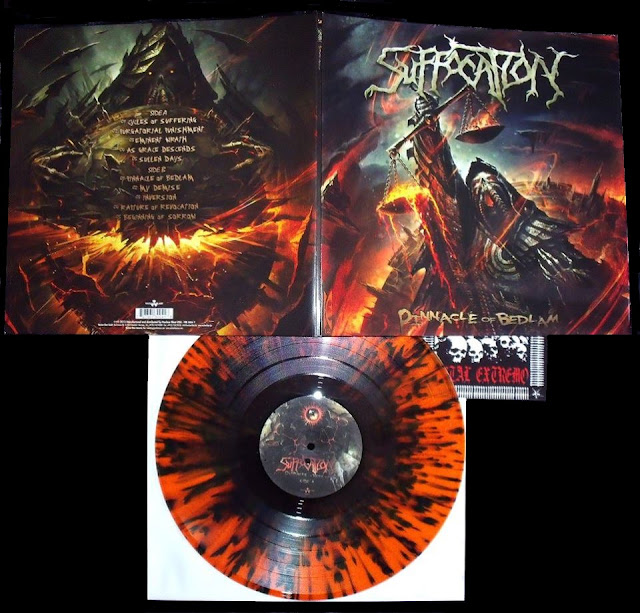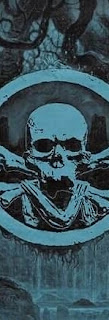Burzum is a music project that began in 1991 by the Norwegian
musician and writer Varg Vikernes. It became a part of the early
Norwegian black metal scene and is considered to be one of the most
influential acts in black metal.
Vikernes began making music in 1988, but it was not until 1991 that he recorded his first demos as
Burzum.
The word "burzum" means "darkness" in the Black Speech, a fictional
language crafted by Lord of the Rings writer J. R. R. Tolkien. Vikernes
recorded the first four Burzum albums between January 1992 and March
1993. However, the releases were spread out, with many months between
the recording and the release of each album.
In May 1994, Vikernes was sentenced to 21 years in prison for the murder
of Mayhem guitarist Øystein "Euronymous" Aarseth and the arson of three
churches. While imprisoned, Vikernes recorded two dark ambient albums
using only synthesizers, as he did not have access to drums, guitar or
bass. Since his release from prison in 2009, he has recorded several
more albums. Although Vikernes is known for his political views, he does
not use Burzum to promote those views, and his lyrics are
non-political.
Varg Vikernes began making music in 1988 with the band Kalashnikov. The
following year, the name was changed to Uruk-Hai, after the creatures
from J. R. R. Tolkien's The Lord of the Rings. In 1990 and 1991,
Vikernes played guitar for the death metal band Old Funeral, which also
consisted of members who would later form the band Immortal. He appears
on the Old Funeral EP Devoured Carcass. Vikernes left Old Funeral in
1991 to concentrate on creating his own musical visions. He had a short
lived project called Satanel, along Abbath Doom Occulta. He then began a
solo project under the name Burzum. The word "burzum" means "darkness"
in the Black Speech, a language crafted by Tolkien. Soon after recording
two demo tapes, he became part of the Norwegian black metal scene. With
his demo tapes, he had attracted attention from Øystein "Euronymous"
Aarseth of Mayhem, who had just recently formed Deathlike Silence
Productions. Aarseth then signed Burzum to the label, and shortly after,
Vikernes (under the pseudonym of Count Grishnackh), began to record
Burzum’s self-titled debut album. According to Vikernes' autobiography
on his website, he had intended to record the album in the worst
recording quality possible (due to this being a typical trademark of the
early Norwegian black metal scene), while still making it sound
acceptable.
Burzum's eponymous debut album was released in 1992,
being the second album released on Deathlike Silence Productions. The
song "War" from this album had a guest appearance from Euronymous,
playing a guitar solo "just for fun", according to Vikernes.
Vikernes has stated that he had never played any live shows with
Burzum,
though at one point was interested in it, so Samoth of Emperor joined
the band as their bassist, though only appearing on the Aske EP.
Additionally, Erik Lancelot was hired to be the band's drummer, though
did not record on any Burzum material, and along with Samoth did not
play a live show. Vikernes had by then lost his interest in playing live
concerts, and stated that he "didn't even need session musicians
anymore". Therefore, Samoth and Lancelot had parted ways with
Burzum. Det som engang var was released as
Burzum's second album in 1993, recorded in 1992.
15 May 1994 saw the release of Hvis lyset tar oss, a new album of previously recorded material from 1992.
Burzum
remained as a solo project until 1994, when Vikernes was arrested for
the murder of Euronymous and the burnings of several churches in Norway.
During his time in prison, Vikernes released his next album, titled
Filosofem, on 1 January 1996. Recorded in March 1993, Filosofem was the
last recording Vikernes made before his imprisonment. Burzum / Aske, a
compilation comprising the Burzum album and Aske EP, was released in
1995. While imprisoned, Vikernes managed to record two other albums in a
dark ambient style. They were released as Dauði Baldrs (1997) and
Hliðskjálf (1999).
In 1998, all
Burzum albums released up to that point were
re-released as vinyl picture discs in a special box set called
1992–1997; however the Filosofem album didn't contain "Rundtgåing av den
transcendentale egenhetens støtte" due to its length. The regular vinyl
issue of Filosofem on Misanthropy had tracks 1–4 plus "Decrepitude II"
on side 1 and "Rundtgåing av den transcendentale egenhetens støtte" on
side 2.
Soon after being released, Vikernes started writing new tracks (nine
metal tracks and an ambient intro and outro) for an upcoming
Burzum
album. According to Vikernes' recounts, several record companies were
interested in releasing his first album in eleven years. He stated about
the new album, "I want to take my time, and make it the way I want it.
It will be metal, and the fans can expect genuine Burzum."
The album was going to be originally titled Den hvite guden ("The White
God"), but he later decided to change it to Belus, which was released by
Byelobog Productions (byelobog is the transliteration of "белобог" in
Slavic languages, meaning "white god") on 8 March 2010. It was also
announced that a movie would be released in 2010, based on Varg
Vikernes' life in the early 1990s. The movie would mainly draw
inspiration from the book Lords of Chaos, with the film being of the
same name. Vikernes expressed his contempt towards both the movie and
the book upon which it is based.
A second new album of original
Burzum material, Fallen, was
released on 7 March 2011, followed by a compilation album, From the
Depths of Darkness, containing re-recordings of tracks from
Burzum's
self-titled album and Det som engang var, on 28 November 2011. A third
new studio album of original material, titled Umskiptar, was released in
May 2012. Sôl austan, Mâni vestan ("East of the Sun, West of the
Moon"),
Burzum's first electronic album since 1999, was released
in May 2013. On April 27, 2013, a song was posted on the official
YouTube channel of Vikernes, titled "Back to the Shadows." In a blog
post, Vikernes stated that "Back to the Shadows" will be the last metal
track released by
Burzum.
The album ''The Ways of Yore'' was released on June 2, 2014.
Burzum's music features characteristics common in black metal,
including distorted, tremolo-picked guitar riffs, and harsh vocals.
Earlier Burzum albums feature very low production quality, which has
improved in albums created after Vikernes' release from prison.
Burzum's
early music shows heavy Tolkien influence; for example, Vikernes' early
moniker "Count Grishnackh" is taken from an orc character called
Grishnákh in Tolkien's works. The choice of the name for the project
reflects both this influence and the desire for anonymity:
Burzum
is a word of the Black Speech of Mordor meaning "darkness" (though
Vikernes views what Christians consider "darkness" as "light"), and is
one of those found on the Ring-inscription of the One Ring (the final
part of the Ring inscription being "...agh burzum-ishi krimpatul", or
"...and in the darkness bind them").
Musically, Burzum has progressed from black metal to
classical-influenced ambient music characterised by minimalist
tendencies and dark atmospheres. Vikernes' music is characterised by
hypnotic repetition and simple song structures; this trademark sound has
been present on Burzum's black metal and electronic albums alike.
Vikernes has described
Burzum as a kind of "spell" or recreation
of an imaginary world tied in with Pagan history. Each album, he claims,
was designed as a kind of "spell" in itself, with each beginning song
intending to make the listener more susceptible to "magic", the
following songs to inspire a "trance-like state of mind", and the last
song to carry the listener into a "world of fantasy" (dreams, for the
listener would fall asleep-Burzum was supposed to have been evening
music). Vikernes claims the intent to create this fantasy world came
from dissatisfaction with the real world. He has stated the "message" of
Burzum can be found in the lyrics of the first song of the first album ("Feeble Screams from Forests Unknown").
-Tracklist:
A1 Feeble Screams From Forests Unknown 7:28
A2 Ea, Lord Of The Depths 4:51
A3 Spell Of Destruction 5:39
B1 Channelling The Power Of Souls Into A New God 3:26
B2 War 2:30
B3 The Crying Orc 0:57
C1 My Journey To The Stars 8:10
C2 Dungeons Of Darkness 4:52
D1 Stemmen Fra Taarnet 6:09
D2 Dominus Sathanas 3:01
D3 A Lost Forgotten Sad Spirit 11:09
-Line up:
• Varg Vikernes: All instruments, vocal.
Label: Back On Black.
Released in a gatefold jacket.
Recorded in Grieghallen Lydstudio, January (Burzum) and August (Aske) 1992 a.y.s.p.
Tracks 1-8: recorded in Grieghallen (Bergen, Norway), January 1992 during the full moon.
Track 10: recorded in Grieghallen, April 1992.
Tracks 9, 11: recorded in Grieghallen, September 1992.
All tracks published by Amazonian Music Publishing (UK).
Under license from Misanthropy Records. Cymophane Productions.
Back on Black is a division of Let Them Eat Vinyl Ltd.
Fantoft Stave Church, Norway.






































